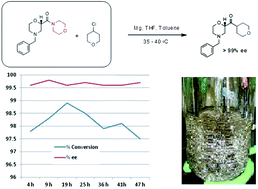A continuous flow Barbier reaction was employed for the production of a key pharmaceutical intermediate (1) in the synthesis of edivoxetine·HCl (a highly selective norepinephrine re-uptake inhibitor).

This process offers up several significant advantages over a traditional Grignard batch process. This continuous flow method gave greater than 30% reduced process mass intensity and magnesium usage relative to the batch method. Equally, the flow process resulted in >100 x less excess magnesium to quench and >100 x less diisobutylaluminum hydride to initiate giving significant safety benefits. The authors expect that the maximum long-term scale of the process is 50 L which would replace 4000-6000 L batch reactors.
This article is free to access until the 11th May 2012! Click on the link below to find out more…
The continuous flow Barbier reaction: an improved environmental alternative to the Grignard reaction?, Michael E. Kopach, Dilwyn J. Roberts, Martin D. Johnson, Jennifer McClary Groh, Jonathan J. Adler, John P. Schafer, Michael E. Kobierski and William G. Trankle, Green Chem., 2012, DOI: 10.1039/C2GC35050E
You may also be interested in the following article as well – free to access for 2 weeks!
Development of safe and scalable continuous-flow methods for palladium-catalyzed aerobic oxidation reactions, Xuan Ye, Martin D. Johnson, Tianning Diao, Matthew H. Yates and Shannon S. Stahl, Green Chem., 2010, 12, 1180-1186
Stay up-to-date with the latest content in Green Chemistry by registering for our free table of contents alerts.










